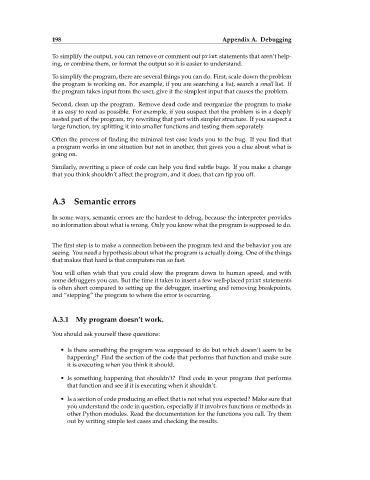Page 220 - thinkpython
P. 220
198 Appendix A. Debugging
To simplify the output, you can remove or comment out print statements that aren’t help-
ing, or combine them, or format the output so it is easier to understand.
To simplify the program, there are several things you can do. First, scale down the problem
the program is working on. For example, if you are searching a list, search a small list. If
the program takes input from the user, give it the simplest input that causes the problem.
Second, clean up the program. Remove dead code and reorganize the program to make
it as easy to read as possible. For example, if you suspect that the problem is in a deeply
nested part of the program, try rewriting that part with simpler structure. If you suspect a
large function, try splitting it into smaller functions and testing them separately.
Often the process of finding the minimal test case leads you to the bug. If you find that
a program works in one situation but not in another, that gives you a clue about what is
going on.
Similarly, rewriting a piece of code can help you find subtle bugs. If you make a change
that you think shouldn’t affect the program, and it does, that can tip you off.
A.3 Semantic errors
In some ways, semantic errors are the hardest to debug, because the interpreter provides
no information about what is wrong. Only you know what the program is supposed to do.
The first step is to make a connection between the program text and the behavior you are
seeing. You need a hypothesis about what the program is actually doing. One of the things
that makes that hard is that computers run so fast.
You will often wish that you could slow the program down to human speed, and with
some debuggers you can. But the time it takes to insert a few well-placed print statements
is often short compared to setting up the debugger, inserting and removing breakpoints,
and “stepping” the program to where the error is occurring.
A.3.1 My program doesn’t work.
You should ask yourself these questions:
• Is there something the program was supposed to do but which doesn’t seem to be
happening? Find the section of the code that performs that function and make sure
it is executing when you think it should.
• Is something happening that shouldn’t? Find code in your program that performs
that function and see if it is executing when it shouldn’t.
• Is a section of code producing an effect that is not what you expected? Make sure that
you understand the code in question, especially if it involves functions or methods in
other Python modules. Read the documentation for the functions you call. Try them
out by writing simple test cases and checking the results.

